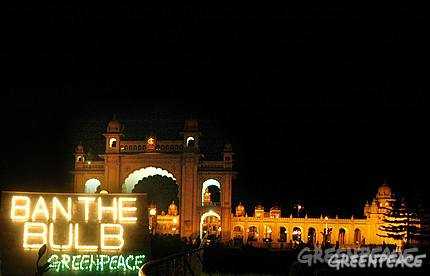“Ban The Bulb”- Campaign In India
Greenpeace India launched the “Ban the Bulb” campaign, calling for a phase out of inefficient light bulbs by 2012.
 |
 |
Ban The Bulb (BTB) campaign is to discourage the use of traditional incandescent bulbs and replacing them with energy efficient lighting. There is a considerable scope of reducing energy consumption through energy efficient lighting schemes. Choosing the right light bulb can help save energy and money.
Greenpeace India launched the “Ban the Bulb” campaign in 2006, calling for a phase out of inefficient light bulbs by 2012. Over 250,000 people signed the Ban the Bulb petition demanding ordinary incandescent bulbs be replaced with efficient ways of lighting. Many joined in human formations to take the message across, while others helped Greenpeace ‘raid’ homes, shops, and hotels to change bulbs.
Greenpeace India
Greenpeace is a non-profit organization, with a presence in 40 countries across Europe, the Americas, Asia and the Pacific. Greenpeace is an independent, campaigning organization which uses non-violent, creative confrontation to expose global environmental problems, and to force the solutions which are essential to a green and peaceful future. Arguing for compact fluorescent lights (CFL), Greenpeace India said: “By replacing ordinary bulbs with CFL, we can reduce India’s carbon dioxide emission by 55 million tones annually as well as save nearly 12,000 MW of power.” The campaign was launched simultaneously in Delhi, Mumbai, Kolkata, Hyderabad, Chandigarh, Pune and Bangalore. Greenpeace activists float a 66 feet life ring at the Gateway of India with a call to ‘Ban the Bulb’ and fight climate change.
 |

[Pics] |
As a part of its campaign to phase out inefficient lighting in India to fight climate change, Greenpeace demonstrates in front of the Mysore Palace on Sunday, July 29th. The Mysore palace, which uses over 96,000 incandescent light bulbs for its illumination, can save Rs 41 Lakhs in electricity bills and a significant amount of electricity and carbon dioxide by switching to compact fluorescent lamps.
Having any query regarding LED Bulbs? Let our Expert help you. Click here. |
Ban The Bulb Campaign Goals
- Remove the price advantage of incandescent Increase the cost of incandescent light bulbs
- Create a deadline for action Ban the sale of incandescent by specific dates Ban 60W + 100W incandescent first (bayonet + screw)
- Help the poor
- Encourage responsible recycling
- Encourage + strengthen supporting legislation
- Encourage continued innovation
- Encourage energy efficiency and conservation
Bachat Lamp Yojana
Greenpeace India launched the Ban the Bulb campaign in 2006, calling for a phase out of inefficient light bulbs by 2012. Three years of creative campaigning resulted in the announcement of “the Bachat Lamp Yojana” by the Government. The “Bachat Lamp Yojana” Program of Activities (PoA) was officially launched in February 2009.The Bachat Lamp Yojana PoA is a scheme developed by Bureau of Energy Efficiency (BEE) to promote energy efficient lighting in India. There are no mandatory requirements in India requiring the use of energy efficient CFL at the household level. All the key players under the scheme like the BEE and participating implementer(s), Electricity Distribution Companies (DISCOMs) and households are voluntarily taking part under this scheme6.
Bureau of Energy Efficiency (BEE)
The Government of India setup Bureau of Energy Efficiency (BEE) on March 1st, 2002 under the provisions of the Energy Conservation Act 2001. The mission of the Bureau of Energy Efficiency is to assist in developing policies and strategies with a thrust on self-regulation and market principles, within the overall framework of the Energy Conservation Act, 2001 with the primary objective of reducing energy intensity of the Indian economy. BEE co-ordinates with designated consumers, designated agencies and other organizations and recognize, identify and utilize the existing resources and infrastructure, in performing the functions assigned to it under the Energy Conservation Act.







